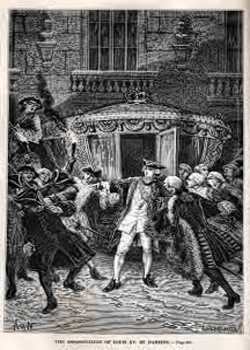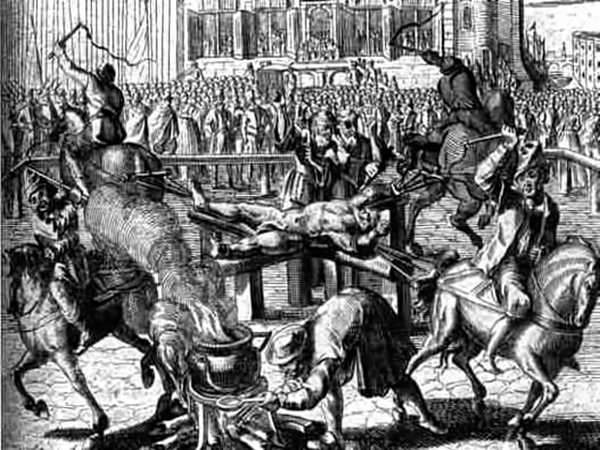Robert-François Damiens, a name etched in history for the failed assassination attempt on King Louis XV, stands as a grim reminder of the brutal methods of capital punishment in 18th-century France. His story is not just a tale of regicide and execution; it reflects the intense religious and political tensions of the time.
Early Life and the Path to Infamy
Born on January 9th, 1715, in northern France, Robert-François Damiens had an unremarkable early life. After serving in the army, he took on various menial jobs, but his unstable temperament led to his dismissal from each one. Reduced to selling cleaning products, Damiens became a man on the fringes of society. Described as a “superstitious enthusiastical sort of a man,” he was easily influenced by the fervent religious atmosphere of the period, particularly by priests who encouraged him to commit regicide.

On January 5th, 1757, Damiens made his move. As King Louis XV was approaching his carriage at Versailles, Damiens lunged at him with a two-bladed knife. The king initially thought he had been punched, but when he saw blood, he realized the seriousness of the attack. Fortunately for Louis XV, his thick winter clothing deflected the blade, resulting in only a minor wound that healed within two weeks.
Arrest and Torture: The Prelude to Execution
Damiens was immediately arrested and subjected to intense interrogation and torture. Despite the brutal methods employed, including the infamous question extraordinaire which involved the use of water torture, Damiens revealed nothing about potential accomplices or motives. He did, however, hint that the Dauphin’s life might also be in danger, adding to the sense of urgency and fear surrounding the incident.
Regicide, or even an attempt at it, was considered one of the gravest crimes imaginable. The Parlement of Paris quickly sentenced Damiens to death, with a punishment designed to match the perceived horror of his crime.
The Grisly Execution
On March 28th, 1757, Damiens was brought to the Place de Grève, Paris’s traditional site of public executions. The execution was a spectacle of unimaginable cruelty, meant to serve as a deterrent to anyone who might consider similar actions against the monarchy.

Damiens was first tortured with red-hot pincers that tore chunks of flesh from his body. This was followed by the pouring of molten lead, boiling oil, burning pitch, and melted wax into his open wounds. His right hand, which had wielded the knife against the king, was covered with blazing sulfur.
But the most notorious part of the execution was yet to come. Damiens was to be drawn and quartered, a method that involved tying his limbs to four horses and having them pull in opposite directions to dismember his body. However, the initial four horses could not accomplish the task, so two more were added. Even then, Damiens’ body held together until the executioner and his assistant began hacking at his joints with knives. Finally, his limbs were torn from his body, which was then thrown onto a pyre and burned to ashes. These ashes were scattered to ensure no remnants of Damiens would remain.
The Aftermath and Historical Significance
The execution of Robert-François Damiens was the last instance of drawing and quartering in France. The severity of his punishment reflected not only the crime but also the deep-seated fear of religiously motivated violence during a time of political instability. The aftermath of his execution was equally severe for his family. His house was destroyed, and his father, wife, and daughter were banished from France, while his siblings were forced to change their names to erase any connection to the infamous regicide.

Even in the context of 18th-century Europe, where public executions were often brutal, the treatment of Damiens stood out for its extraordinary cruelty. Casanova, who witnessed the execution, described the event in his memoirs, noting the horror it evoked, even among those accustomed to such spectacles.
Despite the intended deterrent effect, history records that subsequent French monarchs did face attempts on their lives, culminating in the Revolution, which would see the execution of Louis XVI by guillotine. The brutal punishment meted out to Damiens, rather than quelling dissent, perhaps foreshadowed the bloody upheavals that were to come.
The Enduring Legacy
Robert-François Damiens remains a figure of historical curiosity, his execution often cited as an example of the extremes of pre-revolutionary justice. His story also serves as a stark reminder of the lengths to which authorities would go to protect the sanctity of the monarchy and the profound impact that religious and political fanaticism can have on an individual’s actions.

